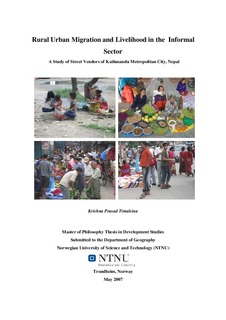| dc.description.abstract | Increasing population pressure at the household level, increasing socio-economic disparities between people and communities, disparities between urban and rural areas, increasing unemployment, unequal land ownership, difficult rural life in general, and conflict in particular have resulted in livelihood vulnerability in the rural areas of Nepal. People are pursuing internal migration as a way of survival strategy among others to create livelihoods in the urban informal sectors. In this context the present study explores increasing rural-urban migration, increase in the informal sector activities and how that impacts on people’s livelihood in the urban areas of Nepal in general and Kathamndu in particular. It further looks at how the situation is linked to rural conflict and displacement in Nepal. Migrants street vendors, as the objects of this study, were selected from Kathamndu Metropolitan City, using purposive snowball sampling to get insights by the qualitative research methodology.
As theories provide certain ways of looking at the world or issues and are essential in defining a research problem, migration theories and livelihood approach are adopted to look at the issues to get insights how poor migrants are making a living in the urban informal sector in Kathmandu. Migration theories have been applied to look at the causes for increasing population in Kathmandu in general, and in the informal sector in particular. Livelihood approach has been adopted to look at the changes in access to assets in different circumstances. It has been looked at how street vendors are making a living and how they have changed the access to assets as compared to their previous occupation. These issues are explained on the basis of analytical framework, which was developed by reviewing migration theories and livelihood approach.
This study shows that the informal sector, including street vending activities in Kathmandu are increasing with increasing rural to urban migration. It has been found that with the increase in the number of street vendors in the urban areas in recent years, the situation is linked to rural conflict and displacement. This study also shows that street vending is an opportunity to rural poor for making a living in the urban areas. The livelihoods of migrant vendors, as compared with their previous occupation, have increased after getting involved in the street vending. Comparing access to assets before and after migration shows migrant vendors have improved their financial and human capital assets by getting better access to physical and political capital assets than before. However, with limited access to physical, financial and political capitals, rural societies have to depend on natural and social capitals for their livelihoods. Thus, there is difference in getting access to assets between urban and rural societies, and street vending in Kathmandu can be accounted as a resource rather than a problem.
However, there are confrontations between authorities and vendors over licensing, taxation and encroachment of public places and pavements. In spite of its crucial role for providing employment and livelihoods to both urban and rural poor, its economic importance is rarely recognized either in national poverty reduction strategies or in city governance initiatives. Urban authorities take it as an illegal and unproductive sector, and their response to street trading is, too often, harassment of traders and eviction, which causes conflict between authorities and vendors. | nb_NO |
